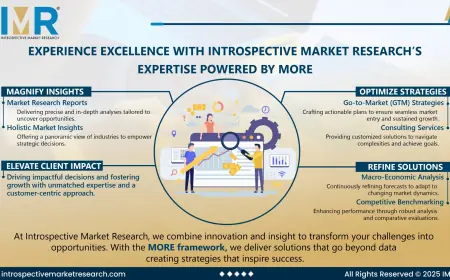Bioplastics & Biopolymers Market Size, Share, and Growth Trends in 2030
Bioplastics & Biopolymers Market Size, Share, and Growth Trends in 2030

The Bioplastics & Biopolymers Market is undergoing a massive transformation as industries worldwide pivot toward sustainable alternatives. Rising concerns over plastic pollution, regulatory pressure against petroleum-based plastics, and increased environmental consciousness among consumers are driving innovation in this sector. With growing adoption in packaging, textiles, automotive, agriculture, and healthcare industries, bioplastics are rapidly becoming integral to the future of global material science.
This detailed analysis explores the market’s key features, future outlook, emerging trends, and a competitive edge for stakeholders.
Industry Key Features
1. Shift from Fossil-Based Plastics to Bio-Based Materials
One of the most defining characteristics of the Bioplastics & Biopolymers Market is its reliance on renewable resources. Unlike traditional plastics derived from petroleum, bioplastics are made from biological substances such as corn starch, sugarcane, vegetable oils, and microbial fermentation by-products. These resources form the foundation of biopolymers like polylactic acid (PLA), polyhydroxyalkanoates (PHA), bio-based polyethylene (bio-PE), and polybutylene succinate (PBS).
2. Biodegradability and Environmental Impact
Biodegradable plastics significantly reduce the environmental burden compared to conventional plastics. These materials break down more efficiently under industrial or natural composting conditions, decreasing the volume of landfill waste and mitigating microplastic contamination. PLA, PHA, and PBS are leading the charge due to their excellent degradability in both aerobic and anaerobic environments.
3. Strong Policy and Regulatory Support
Governments across the world are introducing bans on single-use plastics and incentivizing eco-friendly alternatives. Europe, through its European Green Deal, and Asia-Pacific regions such as China and India, are emphasizing extended producer responsibility (EPR), creating a favorable legislative environment for the growth of bioplastics.
4. Rapid Growth in Packaging Industry
Packaging remains the largest application area for bioplastics, accounting for nearly 45% of market consumption. Both rigid and flexible packaging formats benefit from the lightweight, compostable, and recyclable nature of bio-based polymers. Food & beverage, cosmetics, and e-commerce industries are especially adopting bio-packaging due to branding and sustainability goals.
5. Rising Demand from Automotive and Consumer Goods
The automotive industry uses bio-based polymers in interior trims, dashboards, and upholstery for weight reduction and sustainability. Consumer goods brands are also leveraging bio-based plastics in electronics casings, personal care packaging, and biodegradable household items, reflecting broader green consumerism trends.
6. Technological Advancements and Feedstock Innovation
Research and development in alternative feedstocks like algae, seaweed, and agricultural residues are expanding the material base for bioplastics. Improved polymerization techniques are enhancing the performance characteristics of bioplastics, making them more competitive with conventional polymers.
7. Global Production Capacity Expansion
Global bioplastics production capacity is projected to more than double by 2030. New facilities are being built across Asia-Pacific, Latin America, and Europe to meet the growing demand. Strategic partnerships between material producers and packaging companies are accelerating this growth.
8. Diverse End-Use Applications
Bioplastics are increasingly being used in textiles (bio-fibers), agriculture (biodegradable mulch films), medical devices (biodegradable sutures and implants), and 3D printing, expanding their relevance beyond packaging.
9. Eco-Labeling and Certifications
Certifications such as OK compost, EN 13432, ASTM D6400, and the USDA BioPreferred Program help consumers identify genuine biodegradable and bio-based products, building credibility in the market.
10. Consumer Awareness and Sustainability Trends
Consumers are actively demanding environmentally responsible packaging and products. This behavioral shift is pressuring brands to adopt bio-based solutions, thereby expanding the bioplastics market.
Future Outlook
Strong Growth Forecast Through 2030
The Bioplastics & Biopolymers Market is projected to grow at a CAGR exceeding 15% through 2030. Market value is expected to reach over USD 45 billion during the forecast period, driven by increasing end-user applications, cost competitiveness, and improved functional performance.
Market Shift Toward High-Performance Biopolymers
The market is transitioning from early-stage materials to high-performance biopolymers capable of withstanding thermal, chemical, and mechanical stresses. These advancements will open up new opportunities in sectors like construction, electronics, and automotive engineering.
Geographic Expansion
Asia-Pacific will remain the dominant and fastest-growing region due to abundant raw materials, strong policy support, and the presence of large manufacturing hubs. Europe will continue to lead in innovation, while North America will witness moderate but steady growth backed by corporate sustainability goals.
Cost Competitiveness
As technologies mature and economies of scale are achieved, the cost gap between bioplastics and conventional plastics is narrowing. Lower cost of production and processing will make bioplastics more appealing to price-sensitive markets.
Commercialization of Advanced Materials
Materials such as polyhydroxyalkanoates (PHA), which are fully biodegradable and marine-safe, are expected to reach commercial scale. These advanced materials will differentiate the next wave of products and solutions in the biopolymers segment.
Emerging Trends and Market Drivers
-
Corporate Net Zero Commitments: Companies are incorporating bioplastics to meet their climate targets.
-
Investment Surge: Increased funding from both private equity and governments is catalyzing R&D and infrastructure development.
-
Circular Economy Integration: Bioplastics support circular models due to compostability and recyclability.
-
Collaborative Ecosystems: Industry collaborations are driving material innovation and adoption.
-
Brand Differentiation: Companies leveraging sustainable materials gain consumer trust and competitive edge.
10 Profit Points of Research Report and Competitive Analysis
-
Accurate Forecasting – The report provides well-researched CAGR projections that enable better capital allocation and budgeting.
-
Segmented Opportunity Insights – Granular breakdown of types, applications, and end-users for targeted market entry.
-
Geographic Potential – Pinpoints high-growth regions for global expansion strategy.
-
Competitive Landscape Mapping – Profiles of key players allow benchmarking and partnership exploration.
-
Investment Feasibility – ROI-driven evaluation supports investment decisions.
-
Trend Identification – Market dynamics like biodegradable technology adoption and policy impact are analyzed.
-
Regulatory Intelligence – Understanding of evolving compliance and sustainability mandates.
-
Supply Chain Analysis – Tracks upstream feedstock and downstream product flow.
-
Innovation Hotspots – Highlights emerging technologies that offer disruption or acceleration.
-
Customization Options – Report can be tailored to focus on niche applications or specific geographies.
Conclusion
The Bioplastics & Biopolymers Market stands at the forefront of sustainable innovation in the materials industry. With environmental regulations tightening and consumers becoming more conscious, the demand for biodegradable, compostable, and recyclable materials is poised to accelerate. Technological advancements, cost-efficiency, and multi-sector applications are shaping a resilient and dynamic industry landscape. Companies investing now in R&D, partnerships, and infrastructure are set to benefit most in this high-growth, purpose-driven market.
For more insights and detailed projections, refer to the full market study at:
? Bioplastics & Biopolymers Market – TechSci Research
Contact
TechSci Research LLC
Office Address: 420 Lexington Avenue, Suite 300
New York, NY 10170, United States
Get in Touch:
Phone: +1-332-258-6602
Email: [email protected]
Website: www.techsciresearch.com
Frequently Asked Questions (FAQ)
Q1. What is the current size of the Bioplastics & Biopolymers Market?
The market size is estimated to be between USD 12 to 16 billion in 2024, with expectations to surpass USD 45 billion by 2030, growing at a CAGR of over 15%.
Q2. What are the major types of bioplastics in demand?
Polylactic acid (PLA), Polyhydroxyalkanoates (PHA), bio-based polyethylene (bio-PE), and Polybutylene succinate (PBS) are the leading types due to their biodegradability and wide application scope.
Q3. Which industries are the biggest users of bioplastics?
Packaging is the largest end-use industry, followed by automotive, textiles, agriculture, consumer goods, and healthcare.
Q4. Which region is expected to dominate the bioplastics market?
Asia-Pacific leads the global market and is expected to maintain dominance due to cost-effective production, government support, and large consumer base.
Q5. What are the environmental benefits of bioplastics?
Bioplastics reduce dependence on fossil fuels, offer lower carbon footprints, and are either biodegradable or recyclable, thus minimizing environmental impact.
Q6. How do bioplastics support circular economy goals?
Many bioplastics are compostable and recyclable, supporting closed-loop systems and reducing landfill and ocean pollution.
Q7. Who are the key market players in this industry?
Major players include NatureWorks, Braskem, Total Corbion, BASF SE, Novamont, Danimer Scientific, and Mitsubishi Chemical.
Q8. What is driving consumer demand for bioplastics?
Growing eco-consciousness, preference for sustainable brands, and awareness about plastic pollution are major drivers of consumer demand.
Q9. Are bioplastics more expensive than conventional plastics?
Currently, they may be slightly more expensive, but as production scales and technology improves, the cost is expected to become competitive.
Q10. How do government policies influence market growth?
Bans on single-use plastics, extended producer responsibility (EPR), and tax incentives are key policy tools boosting bioplastics adoption.
What's Your Reaction?
 Like
0
Like
0
 Dislike
0
Dislike
0
 Love
0
Love
0
 Funny
0
Funny
0
 Angry
0
Angry
0
 Sad
0
Sad
0
 Wow
0
Wow
0
























































